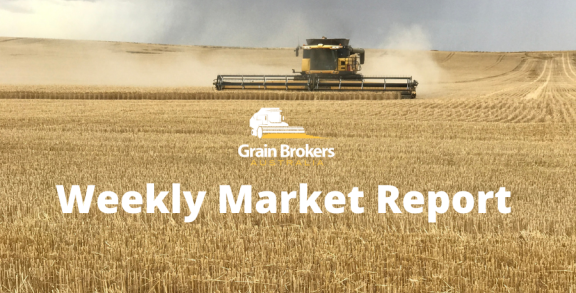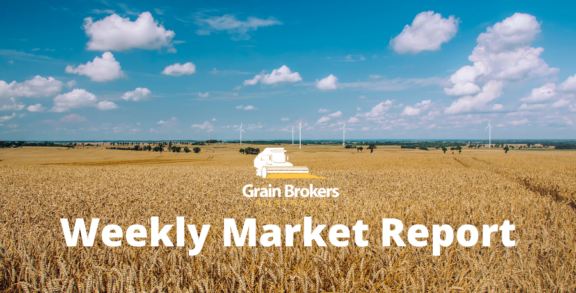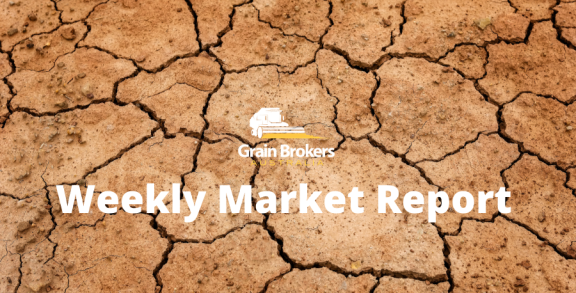
Grain Brokers Australia Weekly Market Report
July 2, 2019
USDA shocks the market…
The United States Department of Agriculture (USDA) released quite startling corn and soybean planting intention numbers late last week, and the futures markets reacted accordingly. The trade was left scratching their heads as the corn number was well above expectations, and the soybean number was the opposite.
According to the USDA, United States (US) farmers have planted 91.7 million acres (37.1 million hectares) of corn, well above the average industry forecast of 86.7 million acres (35.1 million hectares), and only slightly lower than the prospective planting number of 92.8 million acres (37.6 million hectares) released back in March.
In the World Agricultural Supply and Demand Estimates (WASDE) report released earlier in June, the USDA revised the corn area down by 3 million acres (1.2 million hectares) to 89.8 million acres (36.3 million hectares). This was due to the widespread rains and flooding through much of the Corn Belt. It was, therefore, a huge surprise to see the number increase so significantly when the weather continued to delay planting throughout the month.
All this took the wind out of corn futures, with the September contract finishing down 21 cents per bushel (AU$11.80 per metric tonne), or 4.71 per cent, at the close of Friday trade. If the USDA had not lowered the corn area in their June WASDE report, the latest number would probably have been greeted with a far more subdued reaction.
However, after the market closed the USDA said that the National Agricultural Statistics Service (NASS) will conduct a second survey of growers in 14 states and if the newly collected data justify any changes, NASS will publish updated acreage estimates in the Crop Production report due to be released on Monday, August 12.
The anomaly probably occurs as the survey was conducted in the first two weeks of June. At the time of the survey, the area that farmers intended to plant, but had not yet planted due to excessive rainfall, was 15.5 million acres (6.3 million hectares). They may have intended to plant the corn, but the big question is what proportion of that area was actually seeded by month end? Most in the trade believe it is far less than the USDA has reported.
On the soybean front, the USDA reported that US farmers had planted 80 million acres (32.4 million hectares), 4.6 million acres (1.9 million hectares) less than both the average industry estimate and the prospective planting number released back in March.
Soybean futures did not react as much as corn, but they did rally after three down days in a row. The September contract closed 11 cents per bushel (AU$5.75), or 1.22 per cent higher, at the end of last week’s trade.
Improved harvest weather in the US and the fall in corn values pushed wheat prices sharply lower late last week as well. Soft Red Winter futures closed 19½ c/bu (AU$10.20), or 3.57 per cent lower on Friday, erasing all of the week’s gains and finishing only a tad higher than the first trading day in June.
The winter wheat harvest is well and truly underway in the southern plains of the US. The pace is picking up with the weather turning warmer and drier, but it is still lagging the 5-year average by 14 percentage points. Yields reports have been excellent thus far, and the average protein has been improving as the harvest moves north.
Harvest is also underway in Russia. The French consultancy Agritel is not buying the talk of crop damage due to the hot, dry weather, increasing their Russian wheat production estimate to 81.7 million metric tonne (MMT). This is up 2.5MMT from their last estimate and is 13 per cent higher than last year’s production.
Yields are reported to be higher than last year, but lower than the records set in the 2017/18 season. The hot dry finish is likely to push protein levels higher making Russian wheat exports more attractive to global millers.
The European Commission has been forced to cut their European Union wheat production forecast for the 2019/20 season to 142.3MMT. This is down 1.5MMT from last month’s estimate of 143.8MMT, but still more than 10 per cent higher than last season’s drought-affected production of 128.8MMT.
France is the biggest wheat producer in the European Union, and their soft wheat crop is rated 80 per cent good to excellent, unchanged from last week despite the heat wave, and up 6 per cent from this time last year.
In South America, the Buenos Aires Grain Exchange is expecting 6.6 million hectares of wheat to be planted in Argentina, up from their last forecast of 6.4 million hectares. This, of course, will add tonnage to their exportable surplus and increase competition in key Asian markets for Australian exporters.
Here in Australia, it is another season of two opposing stories. Fortunately, the good story accounts for a much higher proportion of the continent’s cropping area than last year, but the drought is still seriously affecting production in substantial parts of eastern Australia.
In most quarters of southern New South Wales, Victoria, South Australia and Western Australia the winter crops are progressing well. Soil moisture levels in most districts are close to average for this time of the year.
However, farmers through central and northern New South Wales and southern Queensland are doing it tough. In some districts, year to date rainfall is the lowest ever, and many have not had a crop since 2016.
The planting window is closing fast. Nonetheless, if sufficient rain came in the next few weeks, many growers would still plant as much as they could. There would most likely be a swing to chickpeas at the expense of cereals, but they need the income, and the only way to get that income is to plant a crop.
But there is one big problem! There is no forecast for substantial rain in the foreseeable future.
Call your local Grain Brokers Australia representative on 1300 946 544 to discuss your grain marketing needs.





